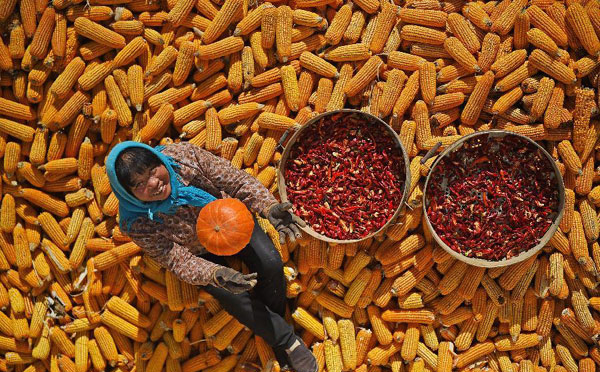Agricultural experts call for diverse approaches to ensure food security

A farmer dries her ripe crops at Liming village, in Yinchuan, Northwest China’s Ningxia Hui Autonomous Region on Oct. 10, 2015.
Phrases such as “paramount necessity” and “self-sufficiency is the bottom line” are often used to describe the importance of food security to national stability. In light of Premier Li Keqiang’s remark on supply-side agricultural reform at the press conference after the closing meeting of the fourth session of China’s 12th National People’s Congress on March 16, scholars have called for diverse approaches to guaranteeing food security.
Top priority
Zhang Xiaoshan, a research fellow of the Institute of Rural Development under the Chinese Academy of Social Sciences, said that the focus of government policy has shifted to emphasize comprehensive productivity and technological innovation in the agricultural sector, in order to shore up agricultural development.
“The government should continue to strengthen support for the main crop-producing regions to ensure the overall growth of crop production and the economy,” said Zhang Junbiao, a professor from the College of Economics and Management at Huazhong Agricultural University.
Zhang said that agricultural production has relied heavily on high input rather than land conservation for a long time, leading to deteriorating agricultural resources and food quality, which directly affects the sustainablity of the food supply. Therefore, short-term risks in food security still exist.
Ma Hua, a professor from the China Urban-Rural Development Institute of Shanxi University, said that under the current circumstances, the adaptability of the traditional agricultural model is at fault, so it is no longer feasible to motivate farmers with price protection.
Only through new thinking, reform and innovation can farmers be incentivized to meet the modern agriculture’s specialization, industrialization, high standards and high-quality production requirements, thus guaranteeing food security, Ma said.
Diverse measures
Scholars said that the supply-side reform measures that the government rolled out to modernize agriculture in the annual “Number One Central Document” earlier this year target the dilemma of concurrent growth of food yields, inventory and imports.
Multiple approaches in supply-side reform are the key to promoting institutional and technological innovation to cut costs and enhance efficiency, Ma said, adding that training for professional farmers is also crucial to increase the pace of change.
Zhang said the primary task is to diversify the supply of agricultural products and adjust regional arrangements to achieve the optimized allocation of resource and products under the guidance of a market-oriented system. Also, it is necessary to change the high-input production model and rely on scientific and technological progress to promote the sustained and healthy development of crop production.
In addition, Zhang said China should enhance the construction of agricultural infrastructure and social service system to compensate for the insufficient supply of agricultural public products.
Increasing farmers’ incomes
“The core issue here is to protect farmers’ interests and enthusiasm,” Zhang said. In China, food security is closely associated to three rural issues—agriculture, countryside and farmers—so farmers must have something to count on and hope for when seeking agricultural and rural development, he added.
Ma said on the strategic level, crop production needs to reduce costs, improve quality and boost brand competitiveness. To be more specific, crop production needs to promote scale management and steadily realize the classification of rural land.
In policy, it is crucial to carry out precise agricultural subsidies, raise food subsidies and make them more efficient, adopt standards for scientific irrigation and water-conservation facilities construction, and improve the quality of farmland by cultivating it in an environmentally-friendly manner, ensuring it will be able to withstand floods and droughts.
Based on the relative importance of various major agricultural products to people’s incomes, the authorities can adopt a gradual approach of “different crops, different subsidy policies” to form market-oriented price mechanisms, Zhang Xiaoshan said. In other words, authorities can achieve a gradual upgrade of agriculture through supply and demand while implementing separate price and subsidy policies to ensure farmers are motivated to grow crops.
Zhang Fan is a reporter at the Chinese Social Sciences Today.

 PRINT
PRINT CLOSE
CLOSE